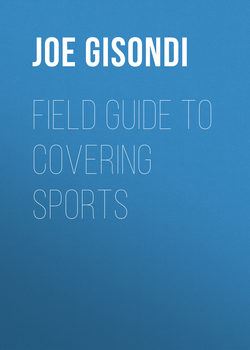Читать книгу Field Guide to Covering Sports - Joe Gisondi - Страница 50
На сайте Литреса книга снята с продажи.
Voice
ОглавлениеVoice is the person behind the page, the reason you and your best friend could write stories on the same subject and they’d sound entirely different. Journalists should have a voice like any other writer. Like a column, feature stories can include commentary and insights from the author. Perhaps the voice of the story is the voice of the person being profiled, where you tell the story through that person’s eyes, or it could be in the voice of the person’s 10-year-old sister. Do not be afraid to take chances.
Sports Insider: On Specific Details
Every sports feature should include the same elements as a really good feature story. The fact that it is a sports story makes it no different. First and foremost, there must be an attention to detail that quickly convinces the reader that the writer knows what he or she is talking about. A writer should accrue as many specific, revealing details as possible. This helps establish the writer’s authority, makes for richer writing, and helps ground the reader in the characters and place where the story is unfolding.
Pamela Colloff, Texas Monthly
“A voice is crucial,” says Dave Hyde, whose piece “Where’s Jake Scott?” won an Associated Press Sports Editors writing award in 2006. “It makes it easier to write. It also makes it easier on the reader—you tell them what’s important through the voice. I typically don’t go first person in long features. Off the top of my head, the Jake Scott story is the only one in which I’ve used the first person. Some people can pull it off well. It just feels forced to me. The reason for using first person in Jake’s story was mainly because this is a guy who hadn’t been interviewed in decades and was living in this exotic locale, so I thought the first scene had to be me approaching the home and trying to interview him. What was it like? How did he take civilization infringing on his life? And I was nervous before doing it myself, because I didn’t know how he’d take it and, let’s face it, the paper was spending some good money to send me there in hopes I could pull it off. So that first scene would set up the rest of the story, I figured. I used the first person through the story—trying not to overplay it—because it was easier to tell his story when he was introducing me to his friends: the taro farmer, the poker player. It wasn’t that I needed to be in the story. It was just that it was the best vehicle to show who he was and how he was living now.”
Like any writing genre, sports writing can’t be easily categorized—especially today when you also have blogs, slideshows, and other multimedia presentations. There are also game precedes, predictions, sports profiles, perspectives on historical events or figures, columns, Q&A pieces, of all sorts of list and analysis presentations. On Bleacher Report, you can find analysis on Serena Williams’ recent loss in the French Open final; an assessment of the best players in each Major League Baseball division is offered in Sports on Earth; and a list of five reasons why the Warriors-Cavs would play out much differently than the previous season is presented on FOXsports.com, analysis on how Golden State’s bench outplayed Cleveland’s starters in Game 1 of the NBA Finals that includes screen shots and video to visually illustrate the main points. Think beyond bats and ball coverage to deliver creative, fun, in-depth pieces that fans will devour.
HEADLINE: A Wonderful Life
BYLINE: Dave Sheinin, Washington Post
You can read the complete story by going to WashingtonPost.com.
